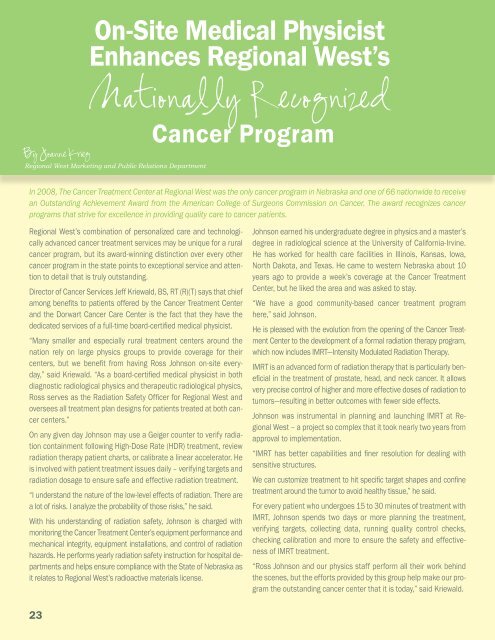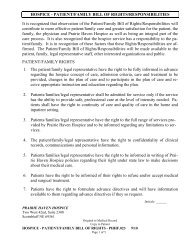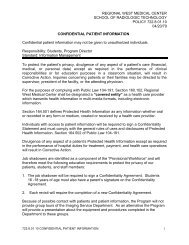2010 Annual Report - Regional West Medical Center
2010 Annual Report - Regional West Medical Center
2010 Annual Report - Regional West Medical Center
You also want an ePaper? Increase the reach of your titles
YUMPU automatically turns print PDFs into web optimized ePapers that Google loves.
On‐Site <strong>Medical</strong> PhysicistEnhances <strong>Regional</strong> <strong>West</strong>’sNationally RecognizedBy Joanne Krieg<strong>Regional</strong> <strong>West</strong> Marketing and Public Relations DepartmentCancer ProgramIn 2008, The Cancer Treatment <strong>Center</strong> at <strong>Regional</strong> <strong>West</strong> was the only cancer program in Nebraska and one of 66 nationwide to receivean Outstanding Achievement Award from the American College of Surgeons Commission on Cancer. The award recognizes cancerprograms that strive for excellence in providing quality care to cancer patients.<strong>Regional</strong> <strong>West</strong>’s combination of personalized care and technologicallyadvanced cancer treatment services may be unique for a ruralcancer program, but its award-winning distinction over every othercancer program in the state points to exceptional service and attentionto detail that is truly outstanding.Director of Cancer Services Jeff Kriewald, BS, RT (R)(T) says that chiefamong benefits to patients offered by the Cancer Treatment <strong>Center</strong>and the Dorwart Cancer Care <strong>Center</strong> is the fact that they have thededicated services of a full-time board-certified medical physicist.“Many smaller and especially rural treatment centers around thenation rely on large physics groups to provide coverage for theircenters, but we benefit from having Ross Johnson on-site everyday,”said Kriewald. “As a board-certified medical physicist in bothdiagnostic radiological physics and therapeutic radiological physics,Ross serves as the Radiation Safety Officer for <strong>Regional</strong> <strong>West</strong> andoversees all treatment plan designs for patients treated at both cancercenters.”On any given day Johnson may use a Geiger counter to verify radiationcontainment following High-Dose Rate (HDR) treatment, reviewradiation therapy patient charts, or calibrate a linear accelerator. Heis involved with patient treatment issues daily – verifying targets andradiation dosage to ensure safe and effective radiation treatment.“I understand the nature of the low-level effects of radiation. There area lot of risks. I analyze the probability of those risks,” he said.With his understanding of radiation safety, Johnson is charged withmonitoring the Cancer Treatment <strong>Center</strong>’s equipment performance andmechanical integrity, equipment installations, and control of radiationhazards. He performs yearly radiation safety instruction for hospital departmentsand helps ensure compliance with the State of Nebraska asit relates to <strong>Regional</strong> <strong>West</strong>’s radioactive materials license.Johnson earned his undergraduate degree in physics and a master’sdegree in radiological science at the University of California-Irvine.He has worked for health care facilities in Illinois, Kansas, Iowa,North Dakota, and Texas. He came to western Nebraska about 10years ago to provide a week’s coverage at the Cancer Treatment<strong>Center</strong>, but he liked the area and was asked to stay.“We have a good community‐based cancer treatment programhere,” said Johnson.He is pleased with the evolution from the opening of the Cancer Treatment<strong>Center</strong> to the development of a formal radiation therapy program,which now includes IMRT—Intensity Modulated Radiation Therapy.IMRT is an advanced form of radiation therapy that is particularly beneficialin the treatment of prostate, head, and neck cancer. It allowsvery precise control of higher and more effective doses of radiation totumors—resulting in better outcomes with fewer side effects.Johnson was instrumental in planning and launching IMRT at <strong>Regional</strong><strong>West</strong> – a project so complex that it took nearly two years fromapproval to implementation.“IMRT has better capabilities and finer resolution for dealing withsensitive structures.We can customize treatment to hit specific target shapes and confinetreatment around the tumor to avoid healthy tissue,” he said.For every patient who undergoes 15 to 30 minutes of treatment withIMRT, Johnson spends two days or more planning the treatment,verifying targets, collecting data, running quality control checks,checking calibration and more to ensure the safety and effectivenessof IMRT treatment.“Ross Johnson and our physics staff perform all their work behindthe scenes, but the efforts provided by this group help make our programthe outstanding cancer center that it is today,” said Kriewald.23
















